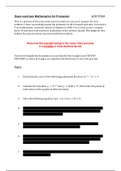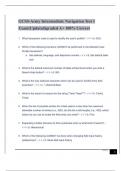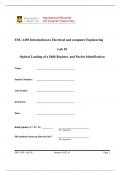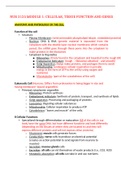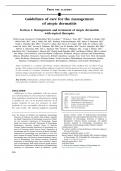§Intermediate microeconomics, games and behaviour
Week 1
Decisions involving uncertainty
• Investments
• Insurance
• Education
• Policy: enivronmental, inequality, safety
• Life
Uncertainty: likelihood of outcomes unknow
Risk: Likelihood of outcomes known
What are risky outcomes?
• Risk describes any economic activity in which there are uncertain outcomes.
• Associated with any uncertain outcome are probabilities.
• Probabilities are numbers between zero and one that indicate the likelihood that a
particular outcome will occur.
• In the absence of a known probability, economic agents have to estimate: they can
estimate based on frequency or based on subjective probability.
Example job choice
Suppose two options:
(1) Job with a certain income of 𝑌 = € 20,000
(2) Job with
- probability 0.5 that 𝑌 = 𝑦1 = € 30,000
- probability 0.5 that 𝑌 = 𝑦2 = € 10,000
Nature= Pseudo player (generates the probabilities, it
decides whether the outcome will be 30.000 or
10.000)
How to compare (1) and (2)?
First calculate the expected values.
Calculating the expected value
The expected value of Y
𝐸 (𝑌) = 𝑃𝑟1 . 𝑦1 + 𝑃𝑟2 . 𝑦2
with:
𝐸 (𝑌) = expected value of 𝑌
𝑦1, 𝑦2 = payoffs (in this example: income)
𝑃𝑟1, 𝑃𝑟2 = probabilities of 𝑦1 and 𝑦2, respectively
The expected value of income from the second job in our example:
𝐸(𝑌) = 0.5 ($30,000) + 0.5 ($10,000) = $ 20,000
Evaluating risky outcomes
,>We need to think in terms of utility Option 1 certain income
Option 2 we have to calculate
expected utility
>we need to understand the decision maker’s preference toward risk
Utility of the expected value 𝑼[𝑬(𝒀)]
The utility of the expected value is the utility an individual has from receiving a certain
amount of money equivalent to the expected value of an uncertain outcome.
(Here in the example is the utility that you derive from 20.000 being a certain outcome)
In our example (option 2):
𝐸(𝑌) = 0.5 (€30,000) + 0.5 (€10,000) = € 20,000
The utility of the expected value 𝑼[𝑬(𝒀)] = 𝑈(€ 20,000)
Does not
consider the
involved
risk!
The expected utility 𝑬(𝑼(𝒀))
The expected utility is the sum of utilities of all possible uncertain outcomes, weighted with
their probability.
In our example (option (2)):
𝑬(𝑼(𝒀)) = 0.5 𝑈(€ 30,000) + 0.5 𝑈(€ 10,000)
Does consider
the involved
risk!
Rational Decision Making with Risk
A decision maker facing a decision problem with a risky payoff 𝑈(𝑌) is rational if he chooses
an action 𝒂 that maximizes his expected utility.
Rational Decision Making with Risk/Uncertainty
A decision maker facing a decision problem with a risky payoff U(Y) is rational if he chooses
an action maximizes his expected utility.
That is a is chosen if and only if
, 𝐸[𝑈(𝑌)|𝑎] ≥ 𝐸(𝑈(𝑌)|𝑏] for all b
where
𝐸[𝑈(𝑌)|𝑎] = 𝑝1𝑎 𝑈(𝑦1 ) + 𝑝2𝑎 𝑈(𝑦2 )
Probability of income y1 if action 𝑎 is chosen Probability of income y2 if action 𝑎 is
chosen
and 𝐸(𝑈(𝑌)|𝑏] equivalently.
A gamble
With a 60 percent chance, you will win €1000 and with a 40 percent chance you will win
€2500.
What is the expected value of this gamble?
𝐸(𝑌) = 0.6 × €1000 + 0.4 × €2500 = €1600
Expected utility of this gamble
The expected utility from the gamble is:
𝐸(𝑈(𝑌)) = 0.6 × 𝑈(€1000) + 0.4 × 𝑈(€2500)
Suppose a person’s utility can be expressed as a function of money in the following way:
𝑈(𝑀𝑜𝑛𝑒𝑦) = √𝑀𝑜𝑛𝑒𝑦
Then the expected utility from the above gamble is:
𝐸(𝑈(𝑌)) = 0.6 × √€1000 + 0.4 × √€2500
𝐸(𝑈(𝑌)) = 0.6 × 31.62 + 0.4 × 50 ≈ 38.97
Utility of the expected value of this gamble
If instead this person were given the expected value of the gamble, €1600, for certain:
𝑈 (𝐸(𝑌)) = √€1600 = 40
In other words, the guaranteed amount of €1600 yields higher utility than the gamble that has
an expected value of €1600.
Utility of expected value > expected utility
This shows that the individual does not like risk:
(s)he is risk averse.
Risk attitudes
Three types:
• Risk averse
• Risk loving (seeking)
• Risk neutral
Risk averse
𝑬(𝑼(𝒀)) < 𝑼[𝑬(𝒀)] > Decision maker prefers the option with the certain income over
the option with the uncertain income, given the same expected value.
The same expected value is not always necessary
, ➢ Say that the decision maker prefers the option with the certain income over the option
with the uncertain income, given the same expected value. Do we always need the
same expected value to draw a conclusion about the risk attitude?
➢ Imagine: Certain income 15
Expected (uncertain) income = 20
Certain income is preferred> risk averse
(not same expected value)
Certain income = 25
Expected (uncertain) income= 20
Certain income is preferred> risk attitude??
(cannot draw a conclusion about the risk attitude because the certain income is higher
than the expected income, it can be caused by risk aversity but also that someone is
neutral and just chooses the higher income)
Risk loving
𝑬(𝑼(𝒀)) > 𝑼[𝑬(𝒀)]
➢ Decision maker prefers the option with the uncertain income over the option with the
certain income, given the same expected value.
Risk neutral
𝑬(𝑼(𝒀)) = 𝑼[𝑬(𝒀)]
➢ Decision maker is indifferent between the option with the certain income and the
option with the uncertain income, given the same expected value.
(They ignore risk, so they always choose the highest payoff)
A risk averse person is willing to
pay to avoid a risk
How much?
Oranje streepje = certainty
equivalent
Certainty equivalent: CE
The certainty equivalent is the certain payoff that generates as much utility as the expected
utility of the gamble.
𝐶𝐸 → 𝑈(𝑌̃) = 𝐸(𝑈(𝑌))
It is determined by equating the utility function to the expected utility and solving for the
income (or wealth).
For our example gamble with utility function U(Y)= √𝑌 we calculated: : 𝐸(𝑈(𝑌)) = 0.6 ×
31.62 + 0.4 × 50 ≈ 38.97
Hence:
Week 1
Decisions involving uncertainty
• Investments
• Insurance
• Education
• Policy: enivronmental, inequality, safety
• Life
Uncertainty: likelihood of outcomes unknow
Risk: Likelihood of outcomes known
What are risky outcomes?
• Risk describes any economic activity in which there are uncertain outcomes.
• Associated with any uncertain outcome are probabilities.
• Probabilities are numbers between zero and one that indicate the likelihood that a
particular outcome will occur.
• In the absence of a known probability, economic agents have to estimate: they can
estimate based on frequency or based on subjective probability.
Example job choice
Suppose two options:
(1) Job with a certain income of 𝑌 = € 20,000
(2) Job with
- probability 0.5 that 𝑌 = 𝑦1 = € 30,000
- probability 0.5 that 𝑌 = 𝑦2 = € 10,000
Nature= Pseudo player (generates the probabilities, it
decides whether the outcome will be 30.000 or
10.000)
How to compare (1) and (2)?
First calculate the expected values.
Calculating the expected value
The expected value of Y
𝐸 (𝑌) = 𝑃𝑟1 . 𝑦1 + 𝑃𝑟2 . 𝑦2
with:
𝐸 (𝑌) = expected value of 𝑌
𝑦1, 𝑦2 = payoffs (in this example: income)
𝑃𝑟1, 𝑃𝑟2 = probabilities of 𝑦1 and 𝑦2, respectively
The expected value of income from the second job in our example:
𝐸(𝑌) = 0.5 ($30,000) + 0.5 ($10,000) = $ 20,000
Evaluating risky outcomes
,>We need to think in terms of utility Option 1 certain income
Option 2 we have to calculate
expected utility
>we need to understand the decision maker’s preference toward risk
Utility of the expected value 𝑼[𝑬(𝒀)]
The utility of the expected value is the utility an individual has from receiving a certain
amount of money equivalent to the expected value of an uncertain outcome.
(Here in the example is the utility that you derive from 20.000 being a certain outcome)
In our example (option 2):
𝐸(𝑌) = 0.5 (€30,000) + 0.5 (€10,000) = € 20,000
The utility of the expected value 𝑼[𝑬(𝒀)] = 𝑈(€ 20,000)
Does not
consider the
involved
risk!
The expected utility 𝑬(𝑼(𝒀))
The expected utility is the sum of utilities of all possible uncertain outcomes, weighted with
their probability.
In our example (option (2)):
𝑬(𝑼(𝒀)) = 0.5 𝑈(€ 30,000) + 0.5 𝑈(€ 10,000)
Does consider
the involved
risk!
Rational Decision Making with Risk
A decision maker facing a decision problem with a risky payoff 𝑈(𝑌) is rational if he chooses
an action 𝒂 that maximizes his expected utility.
Rational Decision Making with Risk/Uncertainty
A decision maker facing a decision problem with a risky payoff U(Y) is rational if he chooses
an action maximizes his expected utility.
That is a is chosen if and only if
, 𝐸[𝑈(𝑌)|𝑎] ≥ 𝐸(𝑈(𝑌)|𝑏] for all b
where
𝐸[𝑈(𝑌)|𝑎] = 𝑝1𝑎 𝑈(𝑦1 ) + 𝑝2𝑎 𝑈(𝑦2 )
Probability of income y1 if action 𝑎 is chosen Probability of income y2 if action 𝑎 is
chosen
and 𝐸(𝑈(𝑌)|𝑏] equivalently.
A gamble
With a 60 percent chance, you will win €1000 and with a 40 percent chance you will win
€2500.
What is the expected value of this gamble?
𝐸(𝑌) = 0.6 × €1000 + 0.4 × €2500 = €1600
Expected utility of this gamble
The expected utility from the gamble is:
𝐸(𝑈(𝑌)) = 0.6 × 𝑈(€1000) + 0.4 × 𝑈(€2500)
Suppose a person’s utility can be expressed as a function of money in the following way:
𝑈(𝑀𝑜𝑛𝑒𝑦) = √𝑀𝑜𝑛𝑒𝑦
Then the expected utility from the above gamble is:
𝐸(𝑈(𝑌)) = 0.6 × √€1000 + 0.4 × √€2500
𝐸(𝑈(𝑌)) = 0.6 × 31.62 + 0.4 × 50 ≈ 38.97
Utility of the expected value of this gamble
If instead this person were given the expected value of the gamble, €1600, for certain:
𝑈 (𝐸(𝑌)) = √€1600 = 40
In other words, the guaranteed amount of €1600 yields higher utility than the gamble that has
an expected value of €1600.
Utility of expected value > expected utility
This shows that the individual does not like risk:
(s)he is risk averse.
Risk attitudes
Three types:
• Risk averse
• Risk loving (seeking)
• Risk neutral
Risk averse
𝑬(𝑼(𝒀)) < 𝑼[𝑬(𝒀)] > Decision maker prefers the option with the certain income over
the option with the uncertain income, given the same expected value.
The same expected value is not always necessary
, ➢ Say that the decision maker prefers the option with the certain income over the option
with the uncertain income, given the same expected value. Do we always need the
same expected value to draw a conclusion about the risk attitude?
➢ Imagine: Certain income 15
Expected (uncertain) income = 20
Certain income is preferred> risk averse
(not same expected value)
Certain income = 25
Expected (uncertain) income= 20
Certain income is preferred> risk attitude??
(cannot draw a conclusion about the risk attitude because the certain income is higher
than the expected income, it can be caused by risk aversity but also that someone is
neutral and just chooses the higher income)
Risk loving
𝑬(𝑼(𝒀)) > 𝑼[𝑬(𝒀)]
➢ Decision maker prefers the option with the uncertain income over the option with the
certain income, given the same expected value.
Risk neutral
𝑬(𝑼(𝒀)) = 𝑼[𝑬(𝒀)]
➢ Decision maker is indifferent between the option with the certain income and the
option with the uncertain income, given the same expected value.
(They ignore risk, so they always choose the highest payoff)
A risk averse person is willing to
pay to avoid a risk
How much?
Oranje streepje = certainty
equivalent
Certainty equivalent: CE
The certainty equivalent is the certain payoff that generates as much utility as the expected
utility of the gamble.
𝐶𝐸 → 𝑈(𝑌̃) = 𝐸(𝑈(𝑌))
It is determined by equating the utility function to the expected utility and solving for the
income (or wealth).
For our example gamble with utility function U(Y)= √𝑌 we calculated: : 𝐸(𝑈(𝑌)) = 0.6 ×
31.62 + 0.4 × 50 ≈ 38.97
Hence:

